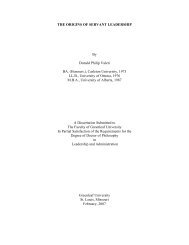mass transfer in multiphase systems - Greenleaf University
mass transfer in multiphase systems - Greenleaf University
mass transfer in multiphase systems - Greenleaf University
You also want an ePaper? Increase the reach of your titles
YUMPU automatically turns print PDFs into web optimized ePapers that Google loves.
MASS TRANSFER IN MULTIPHASE SYSTEMS: VOLATILE ORGANIC COMPOUND<br />
REMOVAL IN THREE-PHASE SYSTEMS<br />
primarily power/volume correlations used for liquids. These are limited and have some<br />
correlations for solid-liquid <strong>mass</strong> <strong>transfer</strong> coefficients for mixed <strong>systems</strong> and were used <strong>in</strong> the<br />
analysis for the System 2 design as well (Oldshue 1983), (Harnby 1992).<br />
Other potentially applicable literature that had various applications <strong>in</strong>cludes (Zhao 2003),<br />
(Muroyama 2001), (Levenspiel 1972), (Fishwick 2003). While some of the work was similar,<br />
there were not any direct analogs. The derivation for 3-phase <strong>mass</strong> <strong>transfer</strong> is unique and has<br />
been published <strong>in</strong> a government-owned document (Ashworth 2004). Relationships between<br />
equilibrium constants (Henry’s constants and solid-liquid partition<strong>in</strong>g) and transient <strong>mass</strong><br />
<strong>transfer</strong> are needed to understand and predict system behavior. These were not found <strong>in</strong> the<br />
literature search and needed to be derived.<br />
The primary process <strong>in</strong> this work dealt with <strong>transfer</strong> of VOCs from a slurry phase <strong>in</strong>to<br />
air-stripp<strong>in</strong>g air. The literature search focused on f<strong>in</strong>d<strong>in</strong>g correlations for a <strong>mass</strong> <strong>transfer</strong><br />
coefficient as a function of the design parameters, e.g., the degree of agitation, gas rate, particle<br />
size and others. It was also desired to f<strong>in</strong>d a theory for us<strong>in</strong>g the Henry’s Law constant and the<br />
solid-liquid partition coefficient to predict the batch rates for different VOCs. The available<br />
literature covered several types of topics <strong>in</strong>clud<strong>in</strong>g: 1) derivations from molecular diffusion as <strong>in</strong><br />
Ficks’ Laws (Thibodeaux 1979) 2) air stripp<strong>in</strong>g studies <strong>in</strong>volv<strong>in</strong>g non-batch, cont<strong>in</strong>uous <strong>systems</strong>,<br />
3) air stripp<strong>in</strong>g studies <strong>in</strong>volv<strong>in</strong>g s<strong>in</strong>gle-phase <strong>systems</strong>, and 4) other topics that while useful, did<br />
not provide an answer especially to the non-homogeneous, multiple-phase nature of the unique<br />
wastes prevalent at the facility.<br />
8



